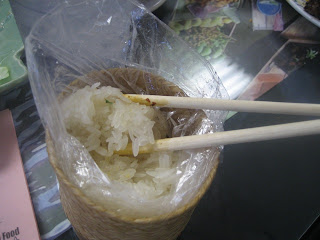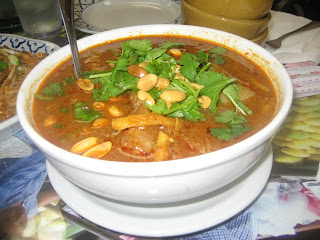What I didn’t realize until I started this “52 cuisines” project, however, is that Thailand’s regional cuisines are as diverse as those of countries many times its size. As subsequent waves of migrants and armies passed through, they brought their cultures, traditions and ingredients to this geographically diverse country that stretches north-to-south for more than 1,000 miles and reaches about 500 miles across at its widest point. Buddhist vegetarianism and Islam’s halal diet have exerted their influence here as well.
Heavily shaped by the cuisines of Laos, Myanmar and the southern reaches of China, Northern Thai is milder and sweeter than the hot and spicy dishes of the south. It’s one you won’t often find on the menu, so when we discovered that Los Angeles has at least one restaurant specializing in it, Himself and I decided we’d best check it out. We went with a group of friends to a mom-and-pop Thai restaurant called Spicy BBQ, where we discovered that the Thai food we’d been eating for many years was exclusively southern.
Along with Nancy, Morris, Rudy, Suzi and Barbara we ordered about a dozen different dishes to share. I’ve always assumed that the quintessential Thai dish was Pad Thai, but it’s actually Khâo Soi, at least in the north. Some say it was brought to the area from Myanmar, while others claim is was carried by Yunnanese Muslims passing through. Regardless of who brought it or where they brought it from, Khâo Soi seems to be to northern Thais what chicken noodle soup is to Americans. This ubiquitous street food is a creamy chicken and peanut soup topped with a handful of flat egg noodles, which give it a nice variety of texture between the crunchy bits floating on top and the chewy bits immersed in the soup.
I think I could have confined myself to Khâo Soi and Northern Thai Sausage and been quite happy. Northern Thai Sausage officially gets the award as my personal favorite item in this meal. The recipe for this sausage is probably as long as my arm—the flavors were varied but well balanced and harmonious, with none overpowering any other. I can’t wait to hit Bangkok Market to see if I can find some to take home.

Morris lingered over the bowl of jasmine rice and inhaled deeply before passing it my way. “Is there a more wonderful aroma?” he mused. It did indeed smell heavenly—fragrant and seductive. But more interesting to me were the small cylindrical baskets of sticky rice, a feature of the Northern Thai menu that comes by way of Laos. Sticky rice is THE rice of Northern Thailand. This isn’t just a rice that sort of clumps together like your average medium- to short-grain rice. No, sticky rice clings to itself for dear life. The idea is to reach into the basket, or kawng khâo, and pinch off a bit of rice, which you press into a ball and then dip into a curry or sauce and eat. I didn’t know this at the time but ended up eating it with my fingers this way, because it clung so tenaciously to itself that I couldn’t manage it with my chopsticks.

As for the Pad Thai, this is the one dish that anyone who has ever eaten Thai food has had. I felt a little bit like a cheater eating it here, in the same way that it would be cheating to order a California Roll in a serious sushi restaurant. But still, it was quite good, light and delicate with well balanced flavors.
This restaurant was recommended to us by Thai chef extraordinaire Jet Tila, who has, of course, unerring judgment in these matters. We took a walking tour of L.A.’s Thai Town a couple of years ago, during which Jet demonstrated how to make pork larb, one of the culinary treasures of northern Thailand. It comes by way of Laos, where it is more or less the national dish. The perfect balance of salty, sweet, hot and sour makes for a happy set of tastebuds.
We may have better photos of this dish, but I like this one for the blur of Jet’s hand as he dusts the larb with toasted and ground jasmine rice, to add an extra depth of flavor to an already remarkable dish (some of ground rice was also added to the meat as it was mixed to bind it).
Just as most Thai restaurants I’ve been to offer the cuisine of the country’s southern region, similarly, most books on Thai cuisine focus almost exclusively on the food of the south. For some reason, the north is considered a poorer, less desirable area. It is mountainous, so farming is a serious challenge. And much of the region remains tribal, with each groups’ own dialects, customs and foods firmly ingrained. I guess it’s a difficult place to get to know well. But now that I know about Northern Thai, I’ll be watching for it in the future. Every now and then I envision being drawn out in search of a good bowl of Khâo Soi. I’ll probably find Morris there, saving me a seat.


















